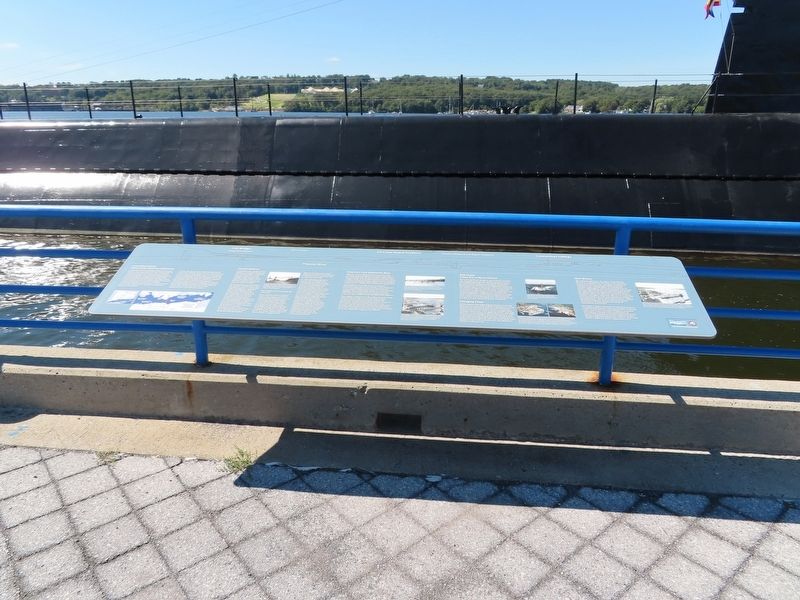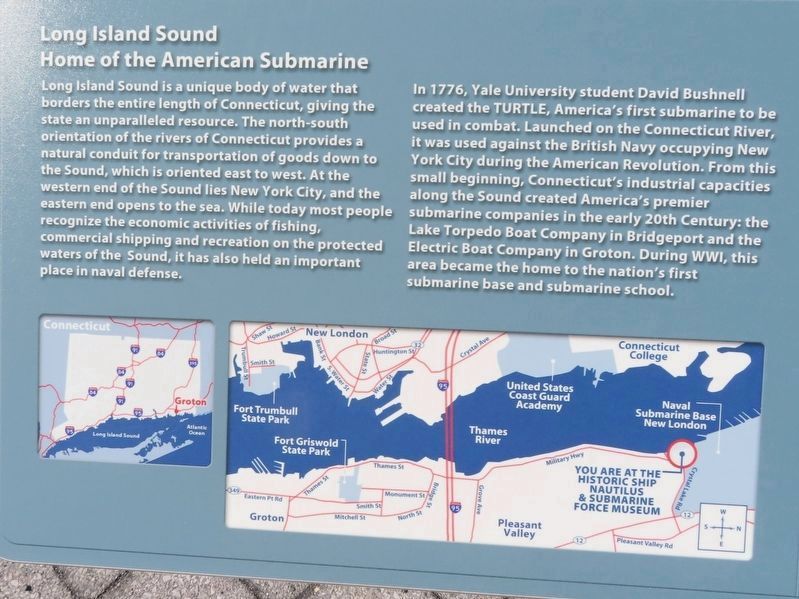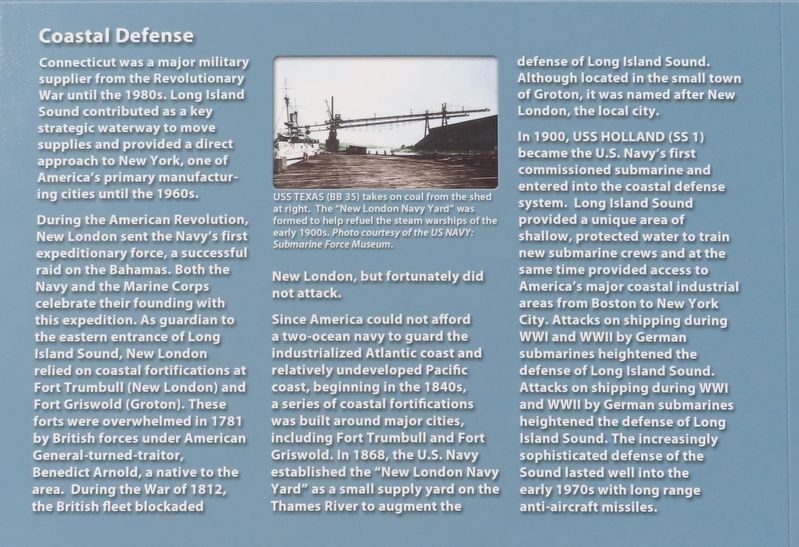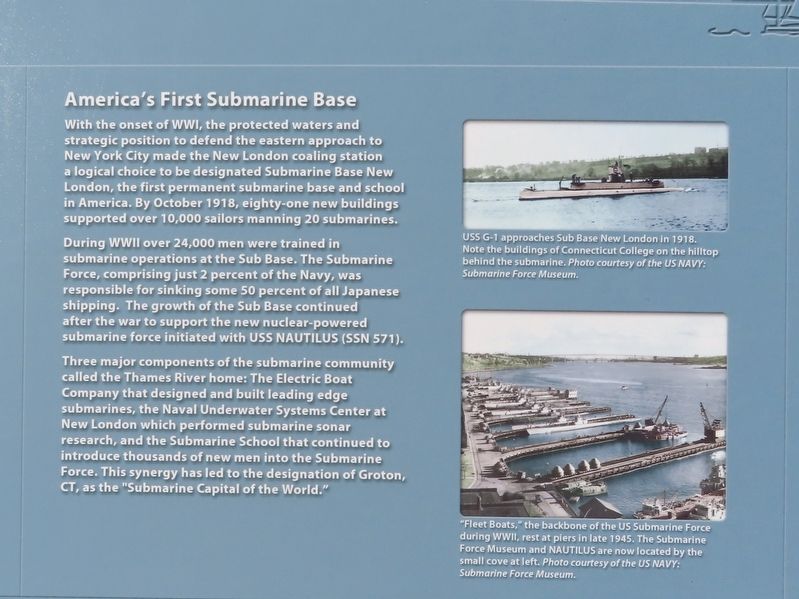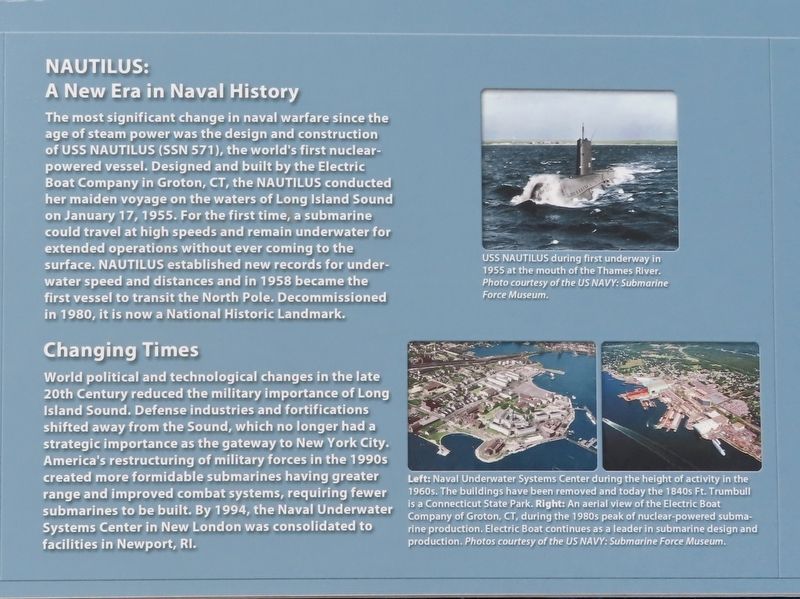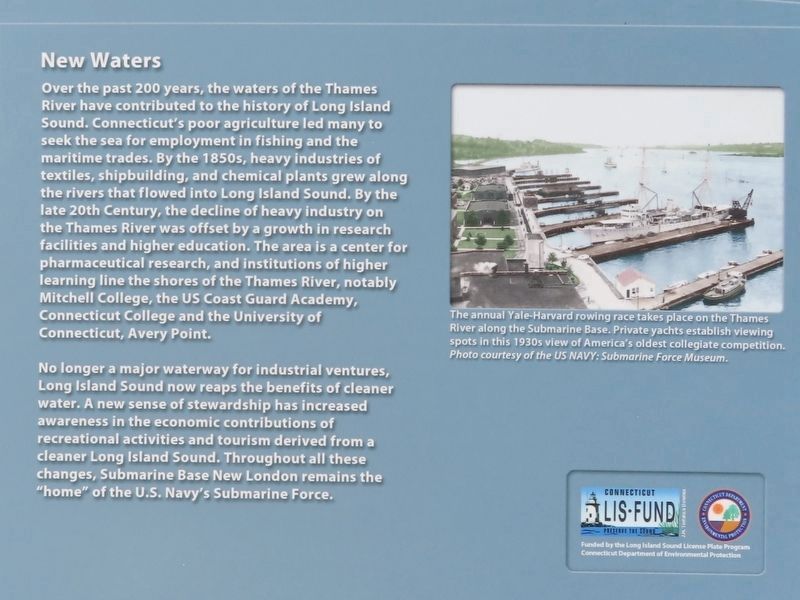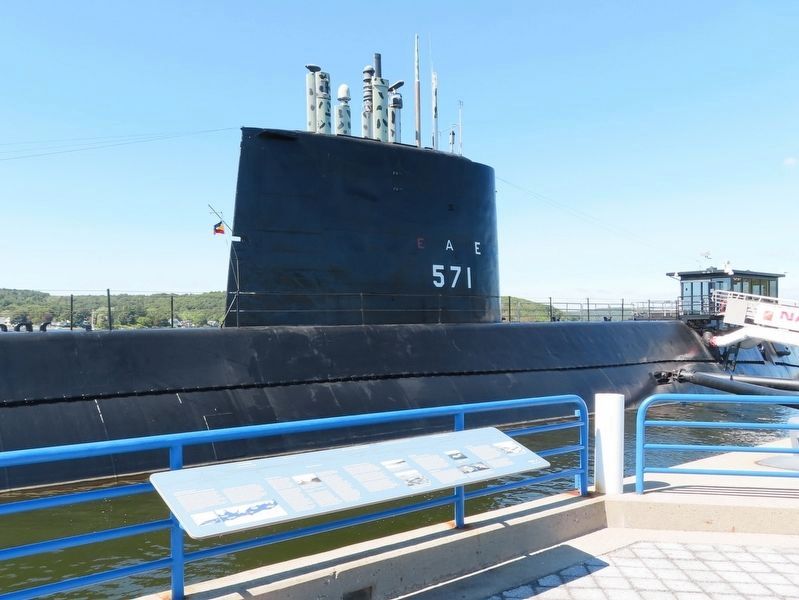Conning Towers-Nautilus Park in Groton in New London County, Connecticut — The American Northeast (New England)
Thames River
Long Island Sound
Home of the American Submarine
Long Island Sound is a unique body of water that borders the entire length of Connecticut, giving the state an unparalleled resource. The north-south orientation of the rivers of Connecticut provides a natural conduit for transportation of goods down to the Sound, which is oriented east to west. At the western end of the Sound lies New York City, and the eastern end opens to the sea. While today most people recognize the economic activities of fishing, commercial shipping and recreation on the protected waters of the Sound, it has also held an important place in naval defense.
In 1776, Yale University student David Bushnell created the Turtle, America's first submarine to be used in combat. Launched on the Connecticut River, it was used against the British Navy occupying New York City during the American Revolution. From this small beginning, Connecticut's industrial capacities along the Sound created America's premier submarine companies in the early 20th Century: the Lake Torpedo Boat Company in Bridgeport and the Electric Boat Company in Groton. During WWI, this area became the home to the nation's first submarine base and submarine school.
Coastal Defense
Connecticut was a major military supplier from the Revolutionary War until the 1980s. Long Island Sound contributed as a key strategic waterway to move supplies and provided a direct approach to New York, one of America's primary manufacturing cities until the 1960s.
During the American Revolution, New London sent the Navy's first expeditionary force, a successful raid on the Bahamas. Both the Navy and the Marine Corps celebrate their founding with this expedition. As guardian to the eastern entrance of Long Island Sound, New London relied on coastal fortifications at Fort Trumbull (New London) and Fort Griswold (Groton). These forts were overwhelmed in 1781 by British forces under American General-turned-traitor, Benedict Arnold, a native to the area. During the War of 1812, the British fleet blockaded New London, but fortunately did not attack.
Since America could not afford a two-ocean navy to guard the industrialized Atlantic coast and relatively undeveloped Pacific coast, beginning in the 1840s, a series of coastal fortifications was built around major cities, including Fort Trumbull and Fort Griswold. In 1868, the U.S. Navy established the "New London Navy Yard" as a small supply yard on the Thames River to augment the defense of Long Island Sound. Although located in the small town of Groton, it was named after New London, the local city.
In 1900, USS Holland (SS 1) became the U.S. Navy's first commissioned
submarine and entered into the coastal defense system. Long Island Sound provided a unique area of shallow, protected water to train new submarine crews and at the same time provided access to America's major coastal industrial areas from Boston to New York City. Attacks on shipping during WWI and WWII by German submarines heightened the defense of Long Island Sound. Attacks on shipping during WWI and WWII by German submarines heightened the defense of Long Island Sound. The increasingly sophisticated defense of the Sound lasted well into the early 1970s with long range anti-aircraft missiles.
America's First Submarine Base
With the onset of WWI, the protected waters and strategic position to defend the eastern approach to New York City made the New London coaling station a logical choice to be designated Submarine Base New London, the first permanent submarine base and school in America. By October 1918, eighty-one new buildings supported over 10,000 sailors manning 20 submarines.
During WWII over 24,000 men were trained in submarine operations at the Sub Base. The Submarine Force, comprising just 2 percent of the Navy, was responsible for sinking some 50 percent of all Japanese shipping. The growth of the Sub Base continued after the war to support the new nuclear-powered submarine force initiated with USS Nautilus (SSN 571).
Three
major components of the submarine community
called the Thames River home: The Electric Boat
Company that designed and built leading edge
submarines, the Naval Underwater Systems Center at
New London which performed submarine sonar
research, and the Submarine School that continued to
introduce thousands of new men into the Submarine
Force. This synergy has led to the designation of Groton,
CT, as the "Submarine Capital of the World."
Nautilus:
A New Era in Naval History
The most significant change in naval warfare since the age of steam power was the design and construction of USS Nautilus (SSN 571), the world's first nuclear- powered vessel. Designed and built by the Electric Boat Company in Groton, CT, the Nautilus conducted her maiden voyage on the waters of Long Island Sound on January 17, 1955. For the first time, a submarine could travel at high speeds and remain underwater for extended operations without ever coming to the surface. Nautilus established new records for underwater speed and distances and in 1958 became the first vessel to transit the North Pole. Decommissioned in 1980, it is now a National Historic Landmark.
Changing Times
World political and technological changes in the late 20th Century reduced the military importance of Long Island Sound. Defense industries and fortifications shifted
away from the Sound, which no longer had a strategic importance as the gateway to New York City. America's restructuring of military forces in the 1990s created more formidable submarines having greater range and improved combat systems, requiring fewer submarines to be built. By 1994, the Naval Underwater Systems Center in New London was consolidated to facilities in Newport, RI.
New Waters
Over the past 200 years, the waters of the Thames River have contributed to the history of Long Island Sound. Connecticut's poor agriculture led many to seek the sea for employment in fishing and the maritime trades. By the 1850s, heavy industries of textiles, shipbuilding, and chemical plants grew along the rivers that flowed into Long Island Sound. By the late 20th Century, the decline of heavy industry on the Thames River was offset by a growth in research facilities and higher education. The area is a center for pharmaceutical research, and institutions of higher learning line the shores of the Thames River, notably Mitchell College, the US Coast Guard Academy, Connecticut College and the University of Connecticut, Avery Point.
No longer a major waterway for industrial ventures, Long Island Sound now reaps the benefits of cleaner water. A new sense of stewardship has increased awareness in the economic contributions of recreational activities and tourism derived
from a cleaner Long Island Sound. Throughout all these changes, Submarine Base New London remains the "home" of the U.S. Navy's Submarine Force.
( photo captions )
— USS Texas (BB 35) takes on coal from the shed at right. The "New London Navy Yard" was formed to help refuel the steam warships of the early 1900s. Photo courtesy of the US Navy: Submarine Force Museum.
— USS G-1 approaches Sub Base New London in 1918. Note the buildings of Connecticut College on the hilltop behind the submarine. Photo courtesy of the US Navy: Submarine Force Museum.
— "Fleet Boats," the backbone of the US Submarine Force during WWII, rest at piers in late 1945. The Submarine Force Museum and Nautilus are now located by the small cove at left. Photo courtesy of the US Navy: Submarine Force Museum.
— USS Nautilus during first underway in 1955 at the mouth of the Thames River. Photo courtesy of the US Navy: Submarine Force Museum.
— Naval Underwater Systems Center during the height of activity in the 1960s. The buildings have been removed and today the 1840s Ft. Trumbull is a Connecticut State Park.
— An aerial view of the Electric Boat Company of Groton, CT, during the 1980s peak of nuclear-powered submarine production. Electric Boat continues as a leader in submarine design and production. Photos courtesy of the US Navy: Submarine Force
Museum.
— The annual Yale-Harvard rowing race takes place on the Thames River along the Submarine Base. Private yachts establish viewing spots in this 1930s view of America's oldest collegiate competition. Photo courtesy of the US Navy: Submarine Force Museum.
Topics. This historical marker is listed in this topic list: Waterways & Vessels. A significant historical date for this entry is January 17, 1955.
Location. 41° 23.223′ N, 72° 5.283′ W. Marker is in Groton, Connecticut, in New London County. It is in Conning Towers-Nautilus Park. Marker can be reached from Crystal Lake Road west of County Route 12 when traveling west. Located at the Submarine Force Library & Museum at the Naval Submarine Base New London. Touch for map. Marker is at or near this postal address: 1 Crystal Lake Road, Groton CT 06340, United States of America. Touch for directions.
Other nearby markers. At least 8 other markers are within walking distance of this marker. USS Nautilus (SSN571) (here, next to this marker); a different marker also named USS Nautilus (SSN571) (a few steps from this marker); USS Nautilus (a few steps from this marker); a different marker also named USS Nautilus (SSN571) (a few steps from this marker); Connecticut State Ship (a few steps from this marker); Japanese Type A (about 300 feet away, measured in a direct line); USS X-1 (SSX-1) (about 300 feet away); Swimmer Delivery Vehicle (SDV) (about 300 feet away). Touch for a list and map of all markers in Groton.
Also see . . .
1. US Navy: Submarine Force Museum. (Submitted on September 20, 2022, by Michael Herrick of Southbury, Connecticut.)
2. USS Nautilus (SSN-571) (Wikipedia). (Submitted on September 20, 2022, by Michael Herrick of Southbury, Connecticut.)
3. Submarine Force Library and Museum (Wikipedia). (Submitted on September 20, 2022, by Michael Herrick of Southbury, Connecticut.)
Credits. This page was last revised on February 10, 2023. It was originally submitted on September 20, 2022, by Michael Herrick of Southbury, Connecticut. This page has been viewed 141 times since then and 25 times this year. Photos: 1, 2, 3, 4, 5, 6, 7. submitted on September 20, 2022, by Michael Herrick of Southbury, Connecticut.
